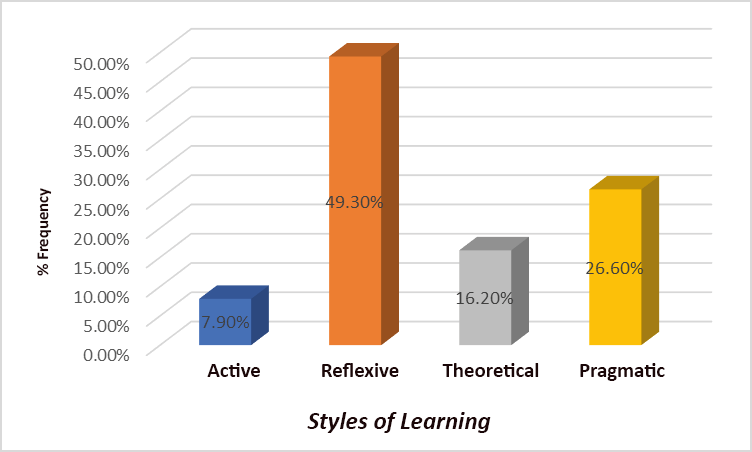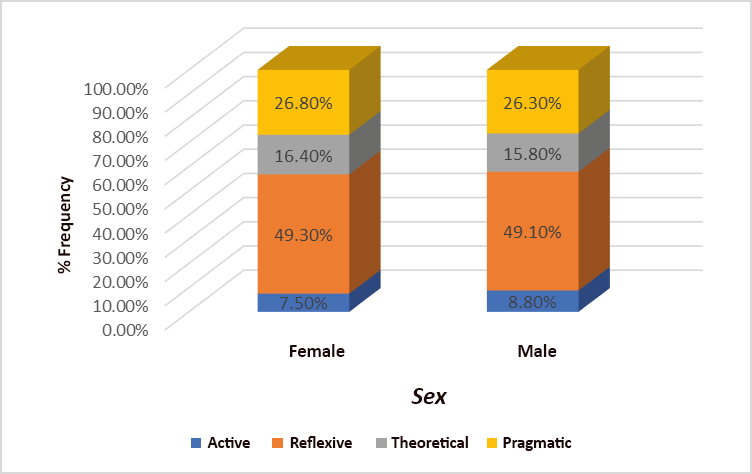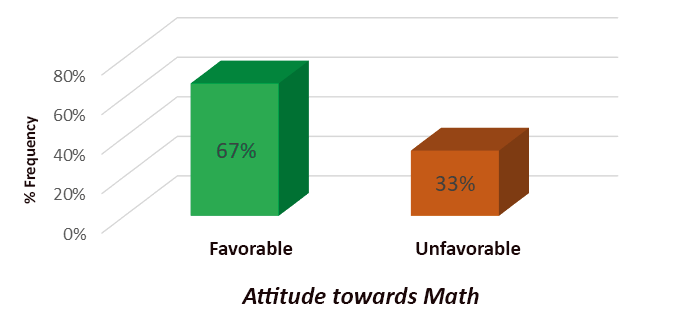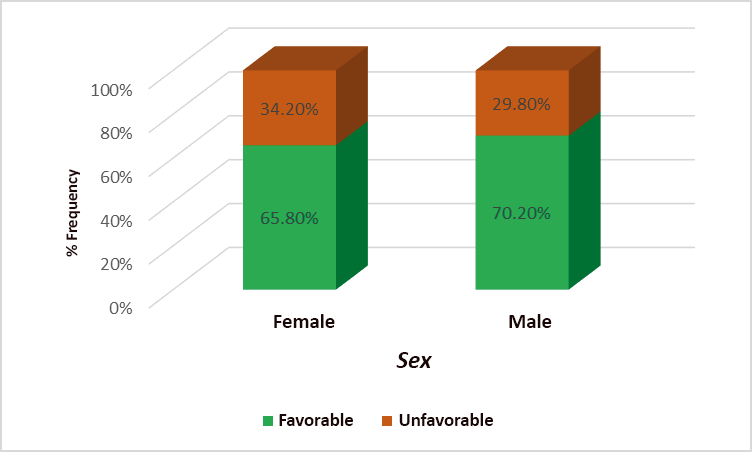ISSN 2410-5708 / e-ISSN 2313-7215
Year 8 | No. 23 | p. 132 - 141 | October 2019 - January 2020
© Copyright (2020). National Autonomous University of Nicaragua, Managua.
This document is under a Creative Commons
Attribution-NonCommercial-NoDerivs 4.0 International licence.
Learning styles and attitudes towards Mathematics in students at POLISAL, UNAN-Managua
https://doi.org/10.5377/torreon.v8i23.9531
Submitted on December 12th, 2019 / Accepted on January 28th, 2020
PhD. Jony Alexander Rojas Rojas
PhD on Science Oriented to Applied Mathematics
UNAN-Managua, Education and Language Faculty
Keywords: learning styles, attitude towards mathematics, POLISAL
The purpose of this research has been the analysis of the relationship between learning styles and attitudes towards Mathematics in students at the Polytechnic Institute of Health (POLISAL), UNAN-Managua. The study was descriptive-correlational, with a population of 427 students of the first years of the Majors offered by POLISAL and a sample of 203 distributed proportionally by shift and major. The simplified CHAEA questionnaire and the attitude scale towards Mathematics were applied to each participant.
The results indicate that the predominant style in the sample is reflective and, in general, the attitude toward Mathematics is favorable. In addition, the non-parametric chi-square method shows that there is no relationship between the study variables, that is, a student’s learning style has no effect on his attitude towards Mathematics.
INTRODUCTION
UNAN-Managua, as a National and International Reference Institution of Higher Education, has the task of researching and improving the teaching and learning processes, in particular the teaching and learning of Mathematics. As an example of this commitment four of the authors of the books of mathematics for Nicaraguan secondary education are teachers from UNAN-Managua. But, to develop skills and abilities aimed at solving social and mathematical problems, it is not enough to develop teaching materials, since this involves several aspects and conditions. Among these aspects are: the ways in which new knowledge is acquired, which according to Kolb (1985) it is possible to have an approximation through learning styles and another aspect is the mental, emotional, academic, economic state, motivational and familiar, that according to Flores and Auzmendi (2015), Flores and Olivar-Molina (2016); Jiménez-Bonilla and Flores (2017); and Flores and Auzmendi (2018) cited by Jiménez-Bonilla and Flores (2019) are related to attitudes towards mathematics. Therefore, the analysis of learning styles and attitudes towards mathematics takes on a preponderant role in the learning of mathematics.
Therefore, the objective of this research document is to determine the relationship between learning styles and the attitude towards Mathematics of the students of the first years in the regular shift, at POLISAL, UNAN-Managua, in the first semester of 2019.
Learning, unlearning and relearning is a mental operation that must be common in every student, particularly in university students. However, if we impartially review the teaching-learning process in Nicaraguan classrooms, we find erroneous knowledge already sacred, especially in mathematics. Hence the interest in studying and / or knowing how our students learn, which irreversibly leads us to have a concrete definition of learning. Since there is no single conceptualization of learning, the conceptualization has been assumed, given by Kolb (1985), Honey & Mumford (1986) and Alonso, Gallego & Honey (1995) which establishes that learning is a process in which the learning subject does so dynamically, in accordance with particular dispositions and characteristics and in which an order and a logical procedure are involved. This implies that the helmsman of the learning process is the subject, who learns or not new knowledge and behaviors from his own perception of the world and his individual and social experiences.
Product of the conceptualization of Honey & Mumford (1986), Alonso & Gallego (1995) create a recipe book that identifies the learning style (active, reflective, theoretical and / or pragmatic), obtained as a result of factor analysis and main components.
The concept of attitude is widely used in the field of psychology, in which attitudes cannot be considered as particular issues, but rather must be understood within a social and temporal context. For Flores and Auzmendi (2018) (cited by Jiménez-Bonilla and Flores (2019)) attitudes are assessments or feelings of acceptance or rejection towards a construct or object that men and women manifest in a context of problem solving with their emotions and beliefs Bazán and Sotero (1998) cited by (Montesinos I., 2017), define attitude towards mathematics as the phenomenon that involves feelings (affective component), beliefs (cognitive component) and students’ tendencies to act in a particular way, approaching or moving away from the mathematical object (behavioral component).
For variable 1, Learning styles, the highest degree of preference shown by the POLISAL student in his daily and academic work is what defines one or another learning style: Active, reflective, theoretical or pragmatic. For variable 2, Attitude towards mathematics, it is defined as the way the POLISAL student acts against mathematics, based on an attitudinal scale that determines his attitude: favorable attitude or unfavorable attitude.
It is important to note that at the national level there are no studies related to the determination of learning styles, much less the analysis of the relationship between learning styles and attitude towards mathematics. However, at the international level the work of Sirmaci (2010) was found in which the relationship between the aforementioned variables is studied, concluding that in the ninth grade students of Erzurum (Turkey) there is no relationship between learning styles and attitude towards mathematics. However, Bünyamin (2016) finds that in Meram students, Konya (Turkey) there is a reasonable relationship between the variables: learning styles and attitude towards mathematics.
METHODOLOGY
Type of investigation
The type of research, according to its level and depth, is descriptive-correlational; descriptive since it is intended to characterize learning styles and attitudes towards mathematics in order to establish the predominant style and attitude (favorable or unfavorable) in POLISAL students. According to Fidias (2012) the purpose of correlational studies is to determine the degree of relationship or association (non-causal) existing between two or more variables, therefore, this study is also correlational because it is desired to respond if there is a relationship between learning styles and attitudes towards mathematics in a sample of the students of the first years of POLISAL.
Participants
The population under study was made up of all the students from the first years of the 9 careers included in the POLISAL, UNAN-Managua, being a total of 427 students, between men and women, whose ages range between 16 and 25 years. The sample was obtained through simple stratified sampling, which consisted of obtaining the subgroup of a division into segments represented by morning and evening shifts, in the first instance, and then by career. In the selection of final subjects by career, random numbers were used. The final distribution of the sample, with an acceptable error = 5%; Confidence level = 95%; Sample size = 203 students of the first years of the POLISAL, is given by the following table.
Table 1. Sample distribution of students of the first years at POLISAL
|
Shift |
Careers |
Nº |
|
Morning |
Clinical Bioanalysis |
19 |
|
Public Health Nursing |
23 |
|
|
Nursing in mother and child |
28 |
|
|
Physiotherapy |
21 |
|
|
Microbiology |
19 |
|
|
Nutrition |
20 |
|
|
Afternoon |
Anesthesia and resuscitation |
26 |
|
Critical Patient Nursing |
22 |
|
|
Nursing in obstetrics and perinatal |
25 |
|
|
Total |
9 |
203 |
Instruments
For Hernández et al. (2010) measuring instrument is any resource that the researcher uses to record data information on the variables he/she intends to study.
For the data collection, two questionnaires were used: The Montesinos questionnaire (2017) to measure the attitude towards mathematics and the CHAEA questionnaire (Honey-Alonso Learning Styles questionnaire) simplified proposed by Hernández and Alonso (2013), to Determine learning styles. For the reliability of the instruments the method of internal consistency was used in a pilot of 40 subjects with the same characteristic of the sample, which resulted in a Cronbach’s Alpha of 0.79 for the attitude towards mathematics 0.84 and in the case of styles Learning. The scale of the instrument to measure the attitude towards mathematics of POLISAL students is Likert type and consists of three dimensions: cognitive, affective and behavioral dimension. The instrument consists of 23 items, with five response options ranging from totally agree to totally disagree; whose typification for the positive items is: 5 points, 4 points, 3 points, 2 points and 1 point. For negative items, the score is reversed.
The simplified CHAEA questionnaire used in the determination of learning styles allowed classifying POLISAL students as active, reflective, theoretical or pragmatic. It consists of 32 items, is a Likert scale type and has six response options, from totally agree to totally disagree. Its typification is: 0 points, 1 point, 2 points, 3 points, 4 points, 5 points and 6 points. It should be noted that to reduce the dimension of the CHAEA questionnaire, Hernández and Alonso (2013) used the statistical technique of multivariate analysis.
RESULTS
Table 2 and Figure 1 show that all learning styles are present in the first year students of POLISAL and although each student may have a predominant learning style, it is observed that the predominant style in the sample is reflective, being this statistically significant characteristic. In addition, it is observed that the pragmatic style is the one that occupies the second place in the order of preference, the least preferred being the active one.
Table 2. Distribution of learning styles throughout the sample.
|
Styles of Learning |
Frequency |
% Frequency |
|
Active |
16 |
7.9% |
|
Reflexive |
100 |
49.3% |
|
Theoretical |
33 |
16.2% |
|
Pragmatic |
54 |
26.6% |

Figure 1. Percentage distribution of learning styles throughout the sample.
When reviewing learning styles by sex, it is observed (see Table 3) that all styles are present and that reflective style is predominant for both. In addition, in general terms there is no significant difference between learning styles by sex (see Figure 2).
Table 3. Distribution of learning styles by sex.
|
Learning styles |
|||||
|
Sex |
Active |
Reflexive |
Theoretical |
Pragmatic |
Total |
|
Female |
11 |
72 |
24 |
39 |
146 |
|
7.5% |
49.3% |
16.4% |
26.8% |
100% |
|
|
Male |
5 |
28 |
9 |
15 |
57 |
|
8.8% |
49.1% |
15.8% |
26.3% |
100 |
|

Figure 2. Percentage distribution of learning styles by sex.
When examining attitudes towards mathematics throughout the sample, it was found (See Table 4 and Figure 3) that 67% of POLISAL students have a favorable attitude towards mathematics, which shows, in general, that although these students will only receive two math subjects in their career, they consider it of importance for their professional development.
Table 4. Distribution of types of attitudes towards mathematics throughout the sample.
|
Attitude towards Math |
Frequency |
%Frequency |
|
Favorable |
136 |
67% |
|
Unfavorable |
67 |
33% |

Figure 3. Percentage distribution of attitudes towards mathematics.
The data contained in Table 5, show that both sexes have a positive attitude towards mathematics, however, the attitude of the male sex in general is better than the female, that is, it continues to predominate that our male students prefer mathematics more than women (see Figure 4).
Table 5. Distribution of types of attitudes towards mathematics by sex.
|
Attitude towards mathematics |
|||
|
Sex |
Favorable |
Unfavorable |
Total |
|
Female |
96 |
50 |
146 |
|
65.8% |
34.2% |
100% |
|
|
Male |
40 |
17 |
57 |
|
70.2% |
29.8% |
100 |
|

Figure 4. Percentage distribution of the attitude towards mathematics by sex.
Finally, when reviewing Table 4 and applying the test statistic x2 with a level of significance α = 0.05 and 3 degrees of freedom, the theoretical value is x2teórico = 7.8147 and the contrast value observed x2observado according to the formula is:

Since x2observado = 6.6249 < 7.8147 = x2teórico then the hypothesis that states that there is no relationship between learning styles and attitudes towards mathematics in students of the first years of the UNAN POLISAL-Managua in 2019 is accepted. That is, the learning style of a student (research participant) has no effect on his/her attitude toward mathematics.
Table 4. Relationship between learning styles and attitudes towards mathematics.
|
Attitudes towards mathematics |
|||
|
Styles of Learning |
Favorable attitude towards Math |
Unfavorable attitude towards Math |
Total |
|
Active |
8 |
8 |
16 |
|
10.7 |
5.3 |
16.0 |
|
|
Reflexive |
74 |
26 |
100 |
|
67 |
33 |
100.0 |
|
|
Theoretical |
18 |
15 |
33 |
|
22.1 |
10.9 |
33.0 |
|
|
Pragmatic |
36 |
18 |
54 |
|
17.8 |
54.0 |
||
|
Total |
136 |
67 |
203 |
|
136 |
67 |
203.0 |
|
CONCLUSIONS
The rationale for this research was to analyze the relationship between the variables, learning styles and attitudes towards mathematics in students of the first years of the UNAN-Managua POLISAL, finding that there is no association between these variables, and therefore both the learning style of a POLISAL student has no effect on his/her attitude towards mathematics. This result is consistent with the findings of Sirmaci (2010) with the difference that Sirmaci makes his study at the middle school level and the present study is at the university level; and it is contrary to the result of Bünyamin (2016) that finds a relationship between the study variables, however, it should be noted that the measuring.
Another relevant aspect found was that, the predominant style is the reflexive, followed by the pragmatic and ultimately the active. In addition, globally, the attitude towards mathematics is favorable for POLISAL students. On the other hand, the analysis by sex showed that men prefer mathematics more than women, the reflexive style is predominant in both sexes, the four learning styles are present in both sexes and there is no differentiation between learning styles by sex.
BIBLIOGRAPHY
Alonso, C., Gallego, D. & Honey, P. (1995). Los estilos de aprendizaje. Procedimientos de diagnóstico y mejora. Bilbao: Ediciones Mensajero.
Bünyamin, A. (2016). Examination of the Relationship between Eighth Grade Students’ Learning Styles and Attitudes towards Mathematics. Journal of Education and Training Studies, 4(2), 124-130.
Bazán, J., y Sotero, H. (1998). Una aplicación al estudio de actitudes hacia las Matemáticas en la Universidad Nacional de la Molina. Retrieved from: http://argos.pucp.edu.pe/~jlbazan/download/1998_62.pdf
Fidias, G. (2012). El proyecto de investigación: Introducción a la metodología científica ( ed.). República Bolivariana de Venezuela: EDITORIAL EPISTEME, C.A.
Flores, W. O. & Auzmendi, E. (2018). Actitudes hacia las matemáticas en la enseñanza universitaria y su relación con las variables género y etnia. Profesorado. Revista de Currículum y Formación de Profesorado, 22(3), 231-251. DOI: https://doi.org/10.30827/profesorado.v22i3.8000
Flores, W., O., & Auzmendi, E. (2015). Análisis de la estructura factorial de una escala de actitud hacia las matemáticas. Aula de Encuentro,17(1), 45-77.
Flores, W. O., & Olivar-Molina, S. (2016). Actitudes hacia la estadística en la formación del profesorado para contextos multiculturales. Revista Universitaria Del Caribe, 17(2), 27-37. DOI: https://doi.org/10.5377/ruc.v17i2.3235
Hernández, M., y Alonso, M. (2013). CHAEA 32 simplificada: Propuesta basada en análisis multivariantes. (Tesis de Maestría). Universidad de Salamanca, México. Retrieved from: file:///C:/Users/Gloria/Documents/II%20Semestre%202019/Monograf%C3%ADa_2019/CHAEA%20simplificado_Propuesta%20basada%20en%20an%C3%A1lisis%20multivarianates.pdf
Hernández, R., Fernández, C., y Baptista, M. (2010). Metodología de la investigación ( ed.). México: Mc Graw Hill.
Honey, P. & Mumford, A. (1986). Manual of Learning Styles. Londres: Deeks.
Alonso, C. & Gallego, D. (2004). Estilos de aprendizaje: teoría y práctica. Madrid: UNED.
Jiménez Bonilla, E., & Flores López, W. (2019). Consideraciones sobre el contenido curricular de matemáticas y su relación con las actitudes. Revista Electrónica De Conocimientos, Saberes Y Prácticas, 2(1), 36-46. https://doi.org/https://doi.org/10.5377/recsp.v2i1.8165
Jiménez-Bonilla, E., & Flores, W., O. (2017). Actitudes hacia las matemáticas: un estudio en una escuela rural de la Costa Caribe Sur de Nicaragua. Revista Universitaria Del Caribe, 18(1), 7-16. DOI:https://doi.org/10.5377/ruc.v18i1.4794
Kolb, D. (1985). Experiential Learning. New Jersey: Prentice Hall.
Montesinos, R. (2017). Actitud frente al aprendizaje de las matemáticas en los estudiantes del cuarto grado de secundaria de la institución educativa “Nicolás Copérnico”, San Juan de Lurigancho, 2015. (Tesis de Licenciatura). Universidad César Vallejos, Perú. Retrieved from: http://repositorio.ucv.edu.pe/handle/UCV/7695
Sirmaci, N. (2010). The relationship between the attitudes towards mathematics and learning styles. Procedia Social and Behavioral Sciences, 9, 644-648.